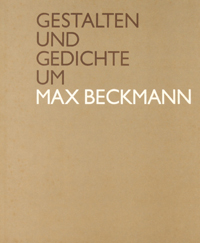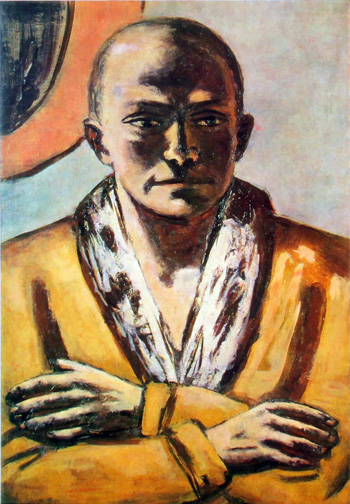< Back to Art Books
< Previous
Next >
Max Beckmann - Collectible Art Books and Artist's Monographs
Der Maler Max Beckmann by Friedhelm W.Fischer
Gestalten und Gedichte Um Max Beckmann by Lili von Braunbehrens
Max Beckmann - Sichtbares und Unsichtbares by Peter Beckmann & Peter Selz
***
Der Maler Max Beckmann by Friedhelm W.Fischer
Max Beckmann
(1884-1950) was born in Leipzig to farmer parents from the area of Braunschweig.
As many other painters, young Max preferred drawing to schoolwork, and began his
formal art studies at the age of sixteen at the Weimar Art Academy.
Beckmann painted freely and was never influenced by any art movement and that is a rare thing to say about any artist living or dead. Of course he studied the classics, but had so real energy and need to express himself that imitation and constrains of any kind, would never have satisfied his lust or vision.
Beckmann was drafted into the First World War and wrote:
"I went across the fields to avoid the straight highways, along the firing lines where people were shooting at a small wooded hill, which is now covered with wooden crosses and lines of graves instead of spring flowers. On my left the shooting had the sharp explosion of the infantry artillery, on my right could be heard the sporadic cannon shots thundering from the front, and up above the sky was clear and the sun bright, sharp above the whole space. It was so wonderful outside that even the wild senselessness of this enormous death. whose music I hear again and again, could not disturb me from my great enjoyment!"

Der Maler Max Beckmann by Friedhelm W.Fischer
מקס בקמן Max Beckmann נחשב לאחד מן הנציגים החשובים ביותר של האקפרסיוניזם הגרמני למרות שלא נמנה עם אף אחת מן הקבוצות של מקימי התנועה (ה"גשר" Die Brucke וה"פרש הכחול" Der Blaue Reiter ). בדרכו האמנותית פעל כל ימיו כבודד וזכה להצלחה רבה כבר בגיל צעיר, בעיקר בשל יכולתו המקצועית המעולה. עם פרוץ מלחמת העולם הראשונה התנדב בקמן לשרות כחובש בחזית המערבית בה התנהלו קרבות מרים שתבעו רבבות קורבנות כבר בחודשי המלחמה הראשונים. הזוועות שהיה עד להן גרמו לבקמן התמוטטות עצבים שבעקבותיה שוחרר מן הצבא. ב-1915 הגיע לפרנקפורט והתאכסן בדירתם של זוג ידידים בה נשאר שנים אחדות. התמוטטות העצבים חלפה אך הלם המלחמה שינה לחלוטין את סגנון ציורו. בפרנקפורט התחילה תקופתו של בקמן האקספרסיוניסט - המלחמה, תבוסתה של גרמניה, וסילוקו של הקייזר עוררו בבקמן תודעה חברתית פוליטית שלא הייתה בו קודם לכן, ואשר באה לידי ביטוי בולט ביצירותיו. הוא נעשה לשונא מלחמות מובהק, ובשנים הראשונות לאחר המהפכה של 1917 אף נטה לסוציאליזם ולקומוניזם. בסדרות של עבודות גרפיות בעלות עוצמה רבה ביטא בקמן את האסון שהמלחמה, והאינפלציה שבאה בעקבותיה, המיטו על החברה הגרמנית, ובעיקר על המוני העם. גם תמונות השמן שלו מבטאות את זעזועו וחרדותיו מהתמוטטות המבנה החברתי בעקבות המלחמה.
בשנות ה-20 נתמנה בקמן לפרופסור באקדמיה לאומנות בפרנקפורט ונחשב לאחד הציירים הגרמנים הידועים ביותר באותה תקופה. על אף שבקמן היה גרמני טהור מבחינה גזעית, פיטרו אותו הנאצים מייד עם עלייתם לשלטון וכללו אותו ברשימת האמנים יוצרי "האמנות המנוונת" שנרדפה על ידיהם. בקמן יצא להולנד באמצע שנות השלושים ונשאר שם עד גמר מלחמת העולם השנייה. כנראה שבעקבות רדיפתו על ידי הנאצים והפיכתו לפליט התפתחה אצלו מחלת לב שהעיקה עליו מאוד כפי שניתן להיווכח מהרשימות ביומנו, אך המחלה לא עצרה ולא ליום אחד את הדחף היצירתי שלו. להפך - טלטולי העיתים עוררו בו כוחות יצירה חדשים שעלו ממעמקי נפשו. בקמן שהיה איש משכיל וקרא ספרות גרמנית, פילוסופיה, ספרים על מיסטיקה, דתות המזרח, גנוסטיקה וקבלה יצר לו מעין מיתולוגיה פרטית ואישית שבוטאה בסדרה של טריפטיכונים בעלי מימדים גדולים שאותם החל לצייר בזמן המלחמה ושעל השלמתם שקד עד סוף חייו. בסך הכל צייר בקמן עשרה טריפטיכונים כאלה, הנמנים היום עם היצירות החשובות של הציור במאה העשרים ובהם ביטא שכבות עמוקות בחיי הנפש שלו, חלומות, סיוטים ומרקמים מן התת-מודע - "ואז התעוררתי ובכל זאת המשכתי לחלום" כמו שתרגמה מדבריו הבלוגרית יונת בפוסט מצויין על מקס בקמן.
עם גמר המלחמה, על אף שאין לתאר אומן גרמני יותר ממקס בקמן, לא חזר בקמן למולדתו
אלא היגר לארה"ב, בה לימד כיתות ציור באקדמיות הקשורות לאוניברסיטאות אמריקאיות
שונות ולבסוף התיישב בניו יורק שאותה אהב מאד - בקמן היה תמיד איש הכרך וחיי העיר
הסואנים לא חדלו מלרתק אותו. בסוף דצמבר 1950, יום אחרי שסיים לצייר את הטריפטיכון
האחרון שלו, ("הארגונאוטים"), מת בקמן מהתקף לב ברחוב ניו יורקי.
.
Hardcover: 96 pages; 41 illustrations,
21 tipped-in full color
Publisher: Verlag M. DuMont Schauberg, Cologne, First edition (1972)
Language: German.
ISBN-10: 3770105974 / 3-7701-0597-4
ISBN-13: 9783770105977 / 978-3770105977
Price:
Call
***
Gestalten und Gedichte Um Max Beckmann by Lili von Braunbehrens
Scholars have long concluded that
Max Beckmann's
lithograph, The Ideologues, from the Hell portfolio of 1919 presents only a
disdainful view of contemporary politics. An examination of the print in context
suggests a somewhat different understanding of Beckmann's response to the
revolution in Germany. The print seems to depict such well-known activist
writers as Carl Einstein, Max Herrmann-Neisse, Annette Kolb, Heinrich Mann, and
Carl Sternheim, all of whom were closely associated with the two leading
journals of German pacifism, Die Aktion and Die weiben Blatter. The backgrounds
and views of these persons - all outspoken opponents of the War, critics of the
Prussian order, champions of the creative spirit or Geist, and initial
supporters of revolution - help us understand why Beckmann represented them. His
caricature mode expresses the profound disillusionment all felt after the final
failure of the German revolution in spring 1919. The skepticism seen in the
print is not simply skepticism about politics - all of these persons distrusted
politics - but skepticism about such persons' ability to deal with the country's
real problems.
In late May 1915 Max Beckmann suffered a nervous breakdown; nothing is known of his whereabouts for the next three months. In September he was in Strasbourg making medical drawings at an institute of hygiene. It was not until October that a friendly doctor had him released from service. Instead of returning to his wife and son in Berlin, he went to Frankfurt where he was put up by his old friend from the days at art school in Weimar, Ugi Battenberg (1879-1957) and his wife Fridel (1880-1965). Ugi, who had stopped painting, handed over his studio on the top floor above their flat to Beckmann, who used it until his departure from Frankfurt in 1933. Their portraits frequently recur in Beckmann's work of the following years, with those of other friends and relations such as their maid Klara, Major von Braunbehrens, Fridel Battenburg, Lili von Braunbehrens, Ugi Battenburg and Wanda von Braunbehrens Major von Braunbehrens was responsible for getting Beckmann discharged from military service in 1917.

Max Beckmann - מקס בקמן
Gestalten und Gedichte Um Max Beckmann (Figures and poems to Max Beckmann) is an
intimate fascinating biography and memories of Max Beckmann written by Lili
von Braunbehrens the daughter of Major von Braunbehrens - a poet who was
closely acquainted with Beckman.

Gestalten und Gedichte Um Max Beckmann
Hardcover: 109 pages including annex
photos & documents
Publisher: Verlag Cruwell - Schropp, Dortmund, First edition (1969)
Language: German.
Price:
Call
***
Max Beckmann - Sichtbares und Unsichtbares by Peter Beckmann & Peter Selz
Max Beckmann (1884 - 1950) is one of the most significant painters in the
history of German art. Beckmann whose early style owes much to
Lovis Corinth,
never attached himself to a particular artistic dogma and developed a highly
personal style of figurative painting. Charged with intense emotional and
symbolic meaning and derived from the art of Grunewald, Brueghel and Van Gogh,
it ranged from the frightening to the tender and the mysterious. Among the
highlights of Beckmann oeuvre are his self-portraits which he painted thorough
his life - Beckmann probably painted more self-portraits than any other artist.
He also painted subjects from the entertainment world, many portraits of family
and friends, and countless allegorical compositions with symbolic characters of
ancient myths.

Max Beckmann - Sichtbares und Unsichtbares by Peter Beckmann & Peter Selz
![]()
This beautiful art album: Sichtbares und Unsichtbares (Visible and Invisible)
includes many plates of the works of Beckman. It was edited by the artist's son
Peter Beckmann who also wrote the afterword based on his father's diary
notes and lectures; the introduction was written by the renowned art historian
and New York museum keeper
Peter Selz.
Hardcover: 151 pages; 51 plates, 32 in
full color
Publisher: Verlag Belser, Stuttgart, First edition (1965)
Language: German.
Price: Call
References:
Emil Nolde by Werner Haftmann
Otto Mueller, E.L.
Kirchner and Otto Dix - German Expressionists
Item: B1035 - Max Beckmann Art Books
© Dan Levy - Art Pane Home of Art Books
< Back to Art Books
< Previous
Next >